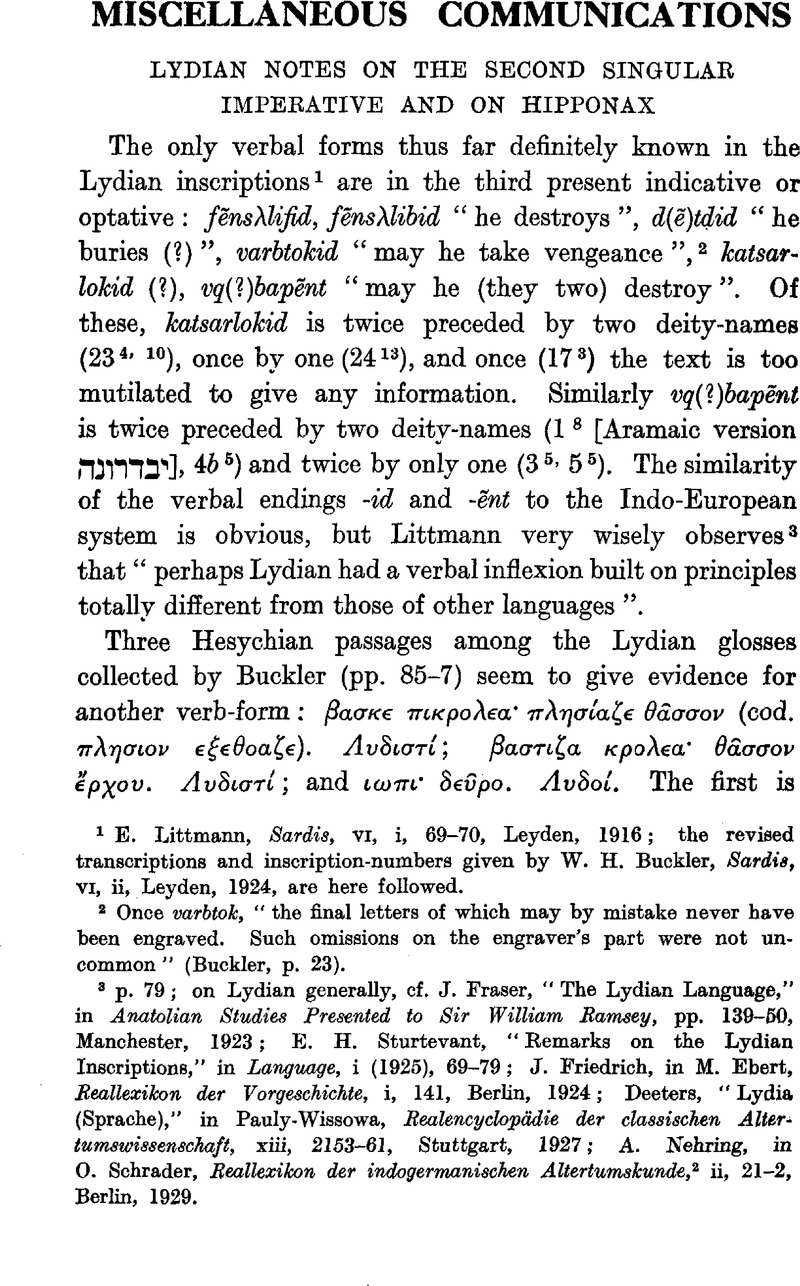No CrossRef data available.
Article contents
Lydian Notes on the Second Singular Imperative and on Hipponax
Published online by Cambridge University Press: 15 March 2011
Abstract

- Type
- Miscellaneous Communications
- Information
- Copyright
- Copyright © The Royal Asiatic Society 1930
References
page 625 note 1 Littmann, E., Sardis, vi, i, 69–70, Leyden, 1916Google Scholar; the revised transcriptions and inscription-numbers given by Buckler, W. H., Sardis, vi, ii, Leyden, 1924, are here followedGoogle Scholar.
page 625 note 2 Once varbtok, “the final letters of which may by mistake never have been engraved. Such omissions on the engraver's part were not uncommon” (Buckler, p. 23).
page 625 note 3 p. 79; on Lydian generally, cf. Fraser, J., “The Lydian Language,” in Anatolian Studies Presented to Sir William Ramsey, pp.139Google Scholar–50, Manchester, 1923; Sturtevant, E. H., “Remarks on the Lydian Inscriptions,” in Language, i (1925), 69–79CrossRefGoogle Scholar; Friedrich, J., in Ebert, M., Reallexikon der Vorgeschichte, i, 141, Berlin, 1924Google Scholar; Deeters, , “Lydia (Spraehe),” in Pauly-Wissowa, , Realencyclopädie der classischen Altertumswissenschaft, xiii, 2153–61, Stuttgart, 1927Google Scholar; Nehring, A., in Schrader, O., ReallexiKon der indogermanischen Altertumskunde,2 ii, 21–2, Berlin, 1929Google Scholar.
page 626 note 1 For y= F in Hesychius of. Hatzidakis, G. N., Einleitung in die neugriechische Grammatik, pp. 117–18, Leipzig, 1892Google Scholar; Bergk, ad loc., reads βασανίκορος, which seems less probable.
page 626 note 2 Sturtevant, pp. 76–7; for various attempts to derive Apollo's name from Greek see Gruppe, O., Griechische Mythologie und Religionsgeschichte, p. 12251, Munich, 1906Google Scholar; Boisacq, B., Dictionnaire étymologique de la langue grecque, pp. 70–1, 1096–7, Paris, 1916Google Scholar.
page 626 note 3 Cf. Tzetzes, , Chiliades, v, 455Google Scholar–6:—
τοîς δέ Αυδοîς καί ‘Ι ωαι ϒοίς έν’ ΕΦέσου τόποις
πρίν πάλμνς βασιλεύς σύμπας έκαλεîτο
page 627 note 1 Hoffmann, O., Griechische Dialekte, iii, 150, Göttingen, 1898; see also Bergk, ad loc.Google Scholar
page 627 note 2 Sayce, A. H., in Classical Review, xxxix (1925), 159CrossRefGoogle Scholar, suggests that the κέρνας and μακέλας of Anthologia Palatina, vii, 709, as well as the Hesychian κέρμηλος άΦ' οὖ Χαλκός ϒίνεται are Lydian (cf. also G. A. Gerhard, in Pauly-Wissowa, viii, 1898–9 (1913). For Hipponax's Kανδαûλαν (1 2 ), “κυνάϒΧα, ακυλλοπνίκτην” see Bolling, G. M., in Language, iii (1927), 15–18CrossRefGoogle Scholar. Hipponax also uses the Phrygian wordsβέκος (82; cf. Herodotus, ii, 2) and νηνίατον (129, cited by Pollux, iv, 79; cf. νινήατος νόμος παιδαριώδης καί Φρύϒιον μέλος [Hesychius]; cf. likewise frag. 135). Lydus, Despite Johannes, de Mensibus, iii, 20Google Scholar: είσἱ δ οΪ Φασι τ Λυδν άρχαίạ Φων τόν ένιαντόν καλεîσθαι σάρδιν the word σάρδιν is not Lydian in origin, but was borrowed from Iranian (Avesta sar∂d, Old Persian θard-; cf. Gray, L. H., in JAOS. xxviii [1907], 334)Google Scholar.


